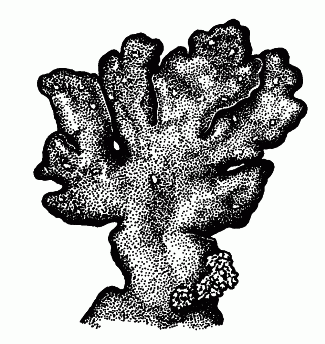Melanelia tominii (Oxner) Essl.
Dimpled rockleather
Parmeliaceae
Introduction to the Lichens
Dimpled rockleather
Parmeliaceae
Introduction to the Lichens
Map
Distribution of Melanelia tominii unavailable
Species Information
General:
Common Name: The Brown Lichens. Describes the colour of the upper surface in this genus. Small to occasionally medium stratified foliose lichens, corticate above and below, sorediate or isidiate or not, pseudocyphellate or not, lobes closely appressed to rather loosely appressed, short to elongate, 0.4–4 (–7) mm wide, thin or somtimes rather thick. Upper surface brown, K-, HNO3- (ours), pruinose or not. Lower surface pale to blackish, bearing short, simple rhizines. Medulla white. Photobiont green.
Apothecia located over upper surface, disc brown; spores simple, ellipsoid, colourless, 8 (–32) per ascus.
Over bark or rock.
Notes: Melanelia is primarily a temperate and boreal genus consisting of about 35 species worldwide. Twentythree of these occur in North America and 17 in B.C. Melanelia was one of several genera recently segregated from the classic genus Parmelia.
Species description:
Soredia and/or isidia present AND
Thallus sorediate, soredio-isidiate (i.e., isidia with “soft” appearance) or, if strictly isidiate, then isidia coloured differently from upper surface AND
Thallus sorediate or if isidiate, then mature isidia either distinctly associated with soralia or strictly cylindrical; over bark, wood or rock; upper surface HNO3- AND
Soralia distinctly delimited and generally tightly packed with soredia (or isidia); habitat various AND
Upper surface generally dark brown or blackening; lobes closely appressed; over rock (very rare over wood) AND
Upper surface bearing distinct scattered pseudocyphellae throughout; lobes typically more than 1.5 mm wide; medulla C+ reddish AND
Pseudocyphellae less than 0.3 mm across, impressed or occasionally lying in same plane as upper surface; lobes convex when mature; apothecia often present; inland
OR
(rare nonsorediate form)
Soredia and isidia absent (Note: low, white-tipped conical warts/papillae may develop over upper surface of some species) AND
Over rock or (rarely) soil AND
Rhizines present below (check near lobe tips); lobes in part concave to plane; distribution various AND
Pseudocyphellae and pycnidia absent or, if present, then scattered over upper surface, pycnidia either somewhat sunken or at most slightly protruding above upper cortex AND
Upper surface brownish or blackish throughout, K-, never white-pruinose; pseudocyphellae, when present, spot-like or at least not elongate-angular; medulla K- (except often K+ orange inMelanelia tominii) AND
Pseudocyphellae distinct over upper surface (check in vicinity of lobe tips) AND
Lower surface blackening (check toward thallus centre); medulla KC+ reddish or PD+ strong orange AND
Rhizines broadcast over lower surface; medulla KC+ reddish, PD-
Reactions:
Medulla C+ reddish, KC+ reddish.
Contents:
Gyrophoric acid and two unknown substances.
Source: Lichens of British Columbia
Illustration

If more than one illustration is available for a species (e.g., separate illustrations were provided for two subspecies) then links to the separate images will be provided below. Note that individual subspecies or varietal illustrations are not always available.
Illustration By: Trevor Goward
Habitat and Range
Habitat: Frequent over acid rock in open inland sites in dry regionsWorld Distribution: circumpolar, S to NM.
Source: Lichens of British Columbia
Synonyms
Synonyms and Alternate Names:
Melanelia substygia (Rasanen) Essl.
Parmelia saximontana R. Anderson & W. A. Weber
Parmelia substygia